
The Crucible of Creation
- The Burgess Shale and the Rise of Animals -
Cat: SCI
Pub: 1998
#: 0218b
Simon Conway Morris
02531u/18216r
Title
The Crucible of CreSummaryation
- The Burgess Shale and the Rise of Animals -
生命創造のるつぼ:
バージス頁岩と動物の興隆
Author
Simon Conway Morris
サイモン・C・モリス
Index
Why?
- In the sea of Cambrian period, we could meet with our possible
ancestor, or other roots of every living creatures of the present.
The imaginary time machine will take us to our really ground zero
place.
Fossils contained in the old hard rocks of Cambrian period will
arouse our interest to our past and predict our future.
- カンブリア紀の海には、我々の祖先かもしれない生物やその他現在のすべての生物のルーツにに出会うことができる。
想像上のタイムマシンは、我々を真のグランド・ゼロの場所に連れて行ってくれる。
古くて堅いカンブリア紀の岩石に含まれる化石は我々の過去への関心を呼び起こし、我々の未来を予測させてくれる。
Summary
要約
>Top 1. The imprint
of evolution:
- We live on a wonderful planet that not only teems with life but
shows a marvelous exuberance of form and variety. In comparison
with the size of the Earth its living skin (biosphere) may be thin,
but it is by no means negligible. Condors cross tropical storms
at altitudes well above 6000m, via the oceans and the green continents,
to deep within the Earth's crust where bacteria are known to live
at depths of al least several km, life is pervasive.
- There could quite easily be twenty million species alive today,
and the number of extinct species must run into the hundreds
of millions, if note in the scheme of evolution, in a new set
of contexts.
the billions.
- We are utterly different from any other form of life that
has ever evolved, how do we know that our origins and history
are to be traced here on Earth rather than as extraterrestrial
immigrants? The reason is simple; our evolutionary pedigree
is stamped on every feature and permeates the entire fabric
of our bodies.
- The basic structure of our arms and our legs, including
the characteristic five fingers and toes (pentadactyl limb), can be traced back over hundreds of millions of years.
- Not only do we and bacteria both use DNA for replication,
but special proteins (histones) that surround the strand
of DNA and assist with keeping its stable and in the correct
configuration are very similar in the sequence of building
blocks (the amino acids) in all life.
- it is an exploration of how a single unit of rock, from
the west of Canada and known as the Burgess Shale, has placed
the history of life, and so by implication Man's place in
the scheme of evolution, in a new set of contexts.
- Just as Darwin's finches from the Galapagos Island exemplify
the recognition of the central role of adaptation, or the
laboratory fly Drosophila strands as a symbol for
the profound successes of molecular biology, so the Burgess
Shale is becoming the icons for those who study the history
of life.
1. 進化の刻印:
- 我々はすばらしい惑星に棲んでいる。単に生命に富んでいるだけでなく驚くほどその形も多様性も豊かである。地球のサイズに比べれば、その生命圏は薄いとは言え、無視できるほどではない。
コンドルは熱帯のストームを横切って高度6000mを飛んで太陽や緑の大陸を横切るし、地殻の奥深く数kmの深さにもバクテリアがいることが知られている。生命は広がりを見せている。
- 今日2000万種の生物がおり、絶滅した種は数十億とはいかないが数億種にも及ぶ。
- 我々はかつて進化したどの種とも決定的に異なっている。我々の起源と歴史が、地球外から移住したのではなくこの地球にあることはどうしてわかるのだろうか。理由は簡単である。我々の進化の歴史が我々の体の一つ一つの特徴に刻み込まれているからだ。
- 手足に5本の指を持つなどの我々の腕や足の基本構造は何億年も遡ることができる。
- 人類もバクテリアも共にDNAを使って複製しているだけでなく、DNAの鎖を囲み安定を保っている特殊なタンパク質(ヒストン)はすべての生命でアミノ酸配列が非常によく似ている。
- バージェス頁岩として知られるカナダ西部の一つの地層の探査を通じて生命の歴史を探究し、進化の過程における人間の位置づけを新たな文脈の中で探っていく。
- あたかもガラパゴス島のダーウィンフィンチが適応進化の中心的な役割として認知されたように、また実験室でショウジョウバエが分子生物学の成功のシンボルになっているように、バージェス頁岩は生命の歴史を研究する者にとってイコンになりつつある。
>Top Organic diversity:
- For those who do not accept speciation as the main motor of organic
diversity, there are broadly two approaches. There are those who
look to the molecular dynamics of the genome, as against those who
seek some wider view that transcends the species.
- Genome:
The genome is much more dynamic that was once thought. For example,
there are large variation in the amount of DNA in different
species, and it is still far from clear why some organisms have
such huge excesses in DNA. There is little connection to complexity:
humans for example have relatively modest amounts of DNA in
each cell.
- Environment:
The Earth has clearly changed dramatically. It appears that
in the past 600 million years (ma) the composition of the atmosphere,
notably in terms of oxygen and carbon dioxide, has changed significantly.
Times of elevated oxygen levels coincide with gigantism and
the development of flight in some animals.
- Further back in time the Moon was probably much close
to the Earth. The proximity of the Moon would then have
generated immense tides. Could this explain, in part, the
sluggishness of organic evolution at this time? Early in
the history of the Earth surface temperature were significantly
elevated, and this too could have exerted a powerful brake
on organic diversification.
- Specific gene:
It is clear that a specific gene is associated with
the expression a complex anatomical feature. One of the best-known
examples involves a so-called master-control gene which plays a
key role in the formation of eyes. First, it transpires that the
same gene (Pax-6) is employed not only in flies and other
insects to build their characteristic compound eyes, but also in
vertebrates. Most probably the Pax-6 gene is very ancient.
It almost certainly predates the animal, presumably some sort of
worm, that about 600 ma ago. This is because its function is to
construct a light-sensitive unit, and such structures are well known
in a number of the more primitive single-celled organisms whose
origins almost certainly predate the animals.
種の分化:
- 生命の多様性の主な原因が「種の分化」ではないと主張する人々には、大まかに2つのアプローチがある。遺伝子の分子力学説と種を越えたより広い原因という2つの説である。
- 遺伝子:
遺伝子はかつて考えられてよりずっとダイナミックである。例えば種によってDNAの量には大きな違いがある。一部の生物になぜこのようにDNAが過剰なのかは全くわかっていない。生物の複雑性とは関係ない。例えば人間は相対的に各細胞中のDNA量は中程度である。
- 環境:
地球は明らかに劇的に変化してきた。過去6億年の間に大気中の酸素と二酸化炭素の比率は大きく変化した。酸素濃度が高まる時期は生物の巨大化と一部の生物の飛行の発達とは一致している。
- 遙か昔には月はおそらくずっと地球に近かった。当時の近い月は遙かに大きな潮汐力を及ぼした。このことはその時期有機物の進化を遅くした原因の一つと説明できるかも知れない。初期の地球の表面温度は高かったこともまた有機物の多様化にとって抑制要因として働いた可能性がある。
- 特定遺伝子:
特定の遺伝子が複雑な解剖学的特徴の表現に関連していることは明らかである。よく知られた例としては、いわゆるマスターコントロール遺伝子が目の形成に重要な役割を演じていることが知られている。まずハエやその他の昆虫に特徴的な複眼だけでなく、脊椎動物においても同じ遺伝子(Pax-6)が目を形成する。おそらくPax-6遺伝子は非常に古くて、動物よりも古く、6億年前のある種の虫にまで遡る。その機能は光を感知する器官を形成する機能であり、その構造はさらに動物より遡る原始的な単細胞生物のおいても見られる。
>Top 2. Setting
the scene:
- Earth history with some of the principal events,
mostly biological. The right column is an expansion of the interval
of geological time that encompasses the
Ediacaran faunas and the Burgess shale. Ma: million years.
- The Earth formed as part of the accretion of the Solar System
about 4600 Ma ago.
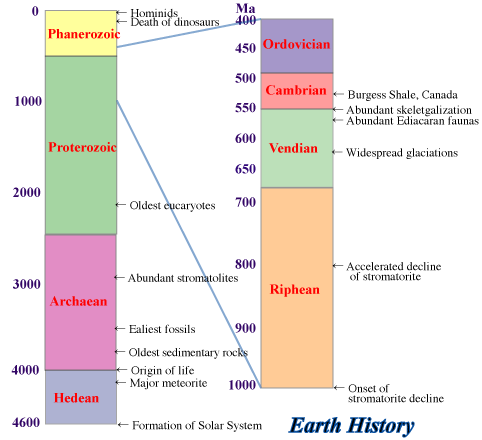
2. 生命の舞台:
- <左図>:生物に注目した地球の歴史。 右のコラムはエディアカラ動物相およびバージェス頁岩を表すために年代の間隔を拡大した。なお、Maは百万年である。
- 地球は約46億年前に太陽系の成長の一部として形成された。
>Top The structure of life:
- Exactly when and how life evolved on Earth is still uncertain, but
there is no doubt that on any human timescale it is extremely ancient.
- Perhaps the first cells were most similar to still-living
bacteria known as eocytes. These bacteria flourish
in hot springs, inhabiting acidic water with a temperature almost
at boiling. Such environments probably characterized the early
Earth.
- For much of the history of the Earth, marked by the intervals
known as the Archaean and Proterozoic (together as Precambrian),
life was dominated by bacteria. Bacteria may be morphologically
simple, but biochemically they are exceedingly complex. They
are able to attack and break down a myriad of otherwise refractory
compounds. Were it not for the activities of bacteria in the
guts of herbivorous animals such as cows and horses, cellulose
would be very difficult for them to digest. The morphological
organization of bacteria is generally rather simple; chains
or sheets of cells.
- The early bombardment had two important consequences.
- First, an important component of the infall to the surface
of the Earth was cometary debris. This was rich in water and
other volatiles, all essential of life.
- Second, the amount of energy released was apparently sufficient
to evaporate the entire ocean and sterilize the Earth's surface.
- The earliest possible evidence for life is in the form of
tiny flakes of carbon, now transmuted into graphite. This graphite
occurs in sediments dated at about 3,800 Ma. At the same time
the meteorite bombardment began to ease off.
- Kingdom:
All the animals, biologically known as the Metazoa, are placed in
a major group of kingdom. Biologists recognize five more kingdoms:
生命の構造:
- 地球上のいつどのようにして生命が進化したのかについてはまだはっきりしないが、人間の時間に比べると遙か大昔の起源であることは確かである。
- 最初の細胞はエオサイトで現生のバクテリアによく似ている。これらのバクテリアは熱湯に近い温度の酸性の温泉に繁殖する。この環境は初期地球環境の特徴でもある。
- 地球の歴史のほとんどは始生代と原生代(いずれも先カンブリア紀) の時代に、生命はバクテリアに支配されていた。バクテリアは形態的には単純かも知れないが、生化学的には非常に複雑である。バクテリアは頑丈な他の化合物を攻撃し分解してしまう。腸内のバクテリアの活動がなければ、牛や馬のような草食動物はまず消化できないだろう。バクテリアの形態は概ね単純で、細胞が鎖状またはシート状である。
- 初期の隕石の衝突は2つの重要な結果をもたらした。
- 第一には、地球への落下物の重要な降下物は彗星の破片であった。これには水や揮発物など生命の誕生に必要なものが多く含まれていた。
- 第二には、放出されたエネルギー量は海全体を蒸発させ、地球表面を消毒した。
- 生命の最初の証拠は、おそらく微小な炭素の断片で、現在はグラファイトに変化している。このグラファイトは約38億年前の堆積岩中に見られる。丁度その頃、隕石落下が収まり始めた頃である。
- 界:
すべての動物は後生動物(原生動物以外) と呼ばれる一つの大きなグループ、動物界を構成する。その他には5つの界に分類される。
>Top Eukaryotes;
- have
larger cells with a nucleus and organelles.
- 1) Animalia (Animals)
- 2) Plantae (Plants)
- 3) Fungi
- 4) Protista (Protistans), which comprise the
seaweeds and single-celled organisms, such as Amoeba.
- Primitive eukaryotic algae are known from rocks in Michigan
about 2100 Ma old.
真核細胞:
- 大きな細胞をもち、核やオルガネラがある。
- 1) 動物界
- 2) 植物界
- 3) 菌界
- 4) 原生生物界
海藻やアメーバなど単細胞生物
- 21億年前に初期の真核細胞の藻類の化石がミシガン州で発見
>Top Prokayote
- smaller
cells, although possess DNA on a chromosome not enclosed in a nucleus;
no mitochondria and no chloroplasts:
- 5) Monera
- Archaebacteria
- Eubacteria
原核細胞:
- 小さな細胞で、DNAはあるが核に囲まれていない。ミトコンドリアや葉緑体もな原核生物
- 5) モネラ界
- 古細菌;メタン細菌
- 真正細
>Top Ediacaran:
- A study of the burrows and tracks (trace fossils)
made on Ediacaran seabeds may also be relevant.
They are effectively restricted to two dimensions. What is conspicuously
absent is any indication for wide-scale churning up of the seabed
by animals living in the sediment.
- There seems to be a sharp demarcation between the strange world
of Ediacaran life and the relatively familiar Cambrian fossils.
The latter are typified by invertebrates such as
trilobites, molluscs, brachiopods, and echinoderms. To a paleontologist
the contrast is dramatic.
エディアカラ動物群:
- エディアカラ の海底の潜穴や這い跡(生痕化石)を研究することは重要である。生痕を作る行動は事実上二次元に限定されていた。それは堆積物中で這い回る動物の形跡は全くなかったのである。
- エディアカラの奇妙な生物の世界と比較的馴染みのあるカンブリア紀の化石の間には明確な境界が見られる。カンブリア紀の典型的な化石は三葉虫、軟体動物、腕足動物、棘皮動物などの無脊椎動物である。古生物学者にとって両者の対比は劇的である。
>Top Cambrian period (550-485 Ma):
- The arrangement of the continents was very different. North
America and Greenland formed an isolated continent in the tropics,
straddling the equator. On the other hand, England were situated
in cool southerly latitudes. Curiously, the higher latitudes of
the northern hemisphere, appears to have been the site of an enormous
ocean, with only scattered islands.
- The fossil record confirms that the seas teemed with life,
but in contrast the continents were effectively vast deserts,
with at most a veneer of primitive vegetation and probably no
animals.
- The climate in cambrian times have been rather warm. Certainly
around the tropical continents the shallow seas were often floored
by limestones and other carbonates, although sands, silts, and
muds also accumulated in many places. A rather remarkable feature
is the general rarity of volcanic deposits.
- The seas were just as salty and the atmosphere had a similar
composition, although with slightly lower concentration of oxygen.
- The Earth rotated somewhat faster so that there were about
400 days in the year.
カンブリア紀: (550 - 485 Ma)
- まず大陸の位置が違う。北アメリカとグリーンランドは一つの大陸を形成し、他から孤立して赤道をまたいだ熱帯にあった。一方、英国は涼しい南半球にあった。奇妙なことに、北半球の高緯度の場所は島がまばらにあるだけの巨大な海が形成されていた
- 化石の記録から海には生命があふれていたが、対照的に大陸は事実上の砂漠でおそらく動物はいなかった。
- カンブリア紀の気候はむしろ温暖だった。熱帯の大陸の周辺の浅い海には、石灰岩や他の炭酸塩岩が堆積し、砂岩やシルトや泥岩もあちこちに堆積していた。顕著な特徴としては、全体的に火山性の堆積物が少ないことである。
- 当時の海は今と同じく塩辛く、大気はほぼ今日と同じような成分だったが、酸素が今より少し少なかった。
- 地球の自転は今より速く、1年は約400日であった。
>Top 3. The discovery of the Burgess Shale:
- Before the advent of cars and aircraft the connecting link had
to be a railway; Building this railway across the Canadian rockies
represents one of the great feats of engineering. The first hint
of the paleontological riches of the area around Field came with
the building of this railway. Field lies in the shadow of Mount
Stephen. Fossils had been found on this mountain at least as early
as 1884. Scattered over part of the mountain were millions of yellowish
slabs on which occurred a profusion of trilobites. These beds are
known as the Ogygopsis shale. This was to prove a harbinger for
the even more extraordinary fossils from the Burgess Shale.
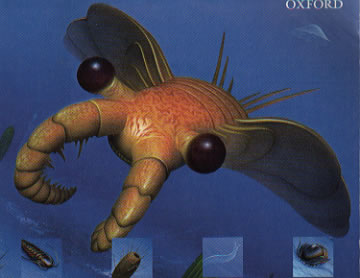 In
1892, by J.F. Whiteaves named this odd fossil Anomalocaris,
literally the 'strange crab'.
In
1892, by J.F. Whiteaves named this odd fossil Anomalocaris,
literally the 'strange crab'.- The route to understanding the Anomalocaris animal was
a catalogue of errors.
- What Derek Briggs had thought were the limbs of a giant centipede-like
animal transpired to be a prominent pair of limbs at the front
of the animal.
- What Charles Walcott had believed to be a jellyfish was now
seen to be an integral part of the animal, forming an extraordinary
mouth and jaw, which was apparently capable of holding and probably
puncturing struggling prey.
- What I had interpreted as a composite fossil, formed by the
chance association of a Peytoia and a sponge, was actually
a poorly preserved specimen of the original animal.
- Harry Whittington's new study showed that this was one of
the most remarkable animals in the Cambrian seas. It probably
grew up to a meter long.
- In addition to the anterior part of limbs, the body carried
a series of flexible lobes. It was argued that their undulatory
motion propelled the animal through the water, in search of
food.
- There was spectacular tail fan, perhaps used to balance the
animal while swimming.
- It were equipped with a series of legs, situated beneath the
lobes. These legs would have enabled the animal to stroll across
the sea floor.
3. バージェス頁岩の発見:
- 車や飛行機の発明以前には、連結には鉄道しかなかった。カナディアンロッキー横断鉄道の建設は土木事業の偉業の一つであった。スティーブンス山陰に位置する地域に、古生物的な宝があるかもしれないという最初の兆候はこの鉄道建設によってもたらされた。スティーブンス山の山陰にその場所はあった。この山に1884年頃に化石が見つかったのである。その山の一部に黄色ぽい板状の岩片が散在しており、その上に沢山の三葉虫が発見された。この地層はオギゴプシス頁岩として知られる。これは別のさらにバージェス頁岩からの途方もない化石が発見される前兆となった。
- <左図>1892年、J.F.ウィティーブスによってこの奇病な化石はアノマロカリスと命名された。奇妙な蟹という意味である。
- アノマロカリスの正体を突き止める道筋は失敗の見本のようだった。
- D.ブリッグスが巨大なムカデのような動物の肢と考えたのは、その動物の前面に飛び出た目立つ一対の肢であった。
- またC.ウォルコットがクラゲであると信じたのは、実はその動物の一部で、恐ろしい口と顎の部分であり、あばれる獲物を捕まえ食いつぶすことができたと思われた。
- 私がペイトシアと海綿とが偶然一緒になった合成化石だと解釈したものは、保存状態は悪いが実はこの動物のものだった。
- H.ウィッチントンの新たな研究によって、アノマロカリスはカンブリア紀でもっとも注目すべき動物の一つであることが判明した。それは1mにも成長した。
- 前方の一対の肢に加えて、しなやかな葉状の突起部(ローブ)がある。その波状の動きで水中を進んで獲物を探したと考えられている。
- また立派な扇状の尾鰭をもっており、これらはおそらく遊泳中のバランスをとるためであったと思われる。
- さらに一連の脚がローブの下にあった。これらの脚で海底を歩き回ることもできたであろう。
>Top Nomenclature:
- When scientists name animals they almost always follow a system
that was codified in the late 18C by swedish botanist, Carl Linne.
This system is known as binominal nomenclature, because two name
are employed. Thus the name for our species is Homo sapiens. Homo is the generic name and sapiens the specific
name. So the full names of the three Burgess Shale arthropods are Marrela splendens, Sidneyia inexpectans, and Burgessia
bella. How clearly each of the species names reveals Walcott's
intense excitement; Marrella the splendid, Sidneyia the unexpected, Burgessia the beautiful.
命名法:
- 科学者が動物を命名するとき、18世紀末のスウェーデンの植物学者カール・リンネの確立した方法に従う。この命名法は属名と種名の二名法として知られる。たとえば人間をホモ・サピエンスというが、ホモは属名、サピエンスは種名である。おなじようにバージェス頁岩の3種の節足動物の正式名は、マーレラ・スプレンシデンス、シドネイア・インエクスペクタンス、バージェシア・ベラとなる。これらの名称には、ウォルコットがこれらの節足動物に出会ったときの興奮が伝わってくる。華麗なマーレラ、予想外のシドネイア、美しいバージェシアという意味である。
>Top 4. Journey
to the Burgess Shale:
- Time travel:
Imagine that time travel was really possible. If a machine capable
of traveling into the past was ever invented, then human curiosity
would know no bounds.
- The time dial has been set for 520 Ma
in the past; the destination is central Canada to visit the
Burgess Shale. Let us suppose that this journey back to the
Cambrian will take an hour. At such a rate of travel, one minute
represents almost 9 Ma, every second is equivalent to almost
150,000 years.
- Human history takes a mere 50 msec.
Homo sapiens has existed for less than 4 seconds. The earliest
hominids, australopithecines, make their debut in Africa after
40 seconds of time travel.
- 7 minutes have gone by. If we stopped
now we would be in time to see the remains of a giant comet
bombard the Earth. We would be witnessing the end-Cretaceous
extinctions, which took place some 65 Ma ago.
- After 25 minutes, the first mammals
appear, a little before the earliest dinosaurs. Passing the
mass extinction at the end of the Permian period, we now hurtle
back through the Paleozoic.
- After 35 minutes hovering over what
is now England, we would see a landscape covered by dense forests,
luxurious plant growth flouring in a hot and humid atmosphere.
Although England at this time is close to the equator, Australia
is near to the South Pole.
- Trees disappear, and after 50 minutes
have elapsed the only plants visible are those that form a thin
cover, restricted to wet bogs and the edges of streams.
- The end of the journey is in sight;
in an hour we have traveled back to the Middle Cambrian.
4. バージェス頁岩への旅:
- タイムトラベル:
過去への旅が可能と考えてみよう。もし過去に戻れるタイムマシーンが発明されたら、我々の興味は際限なく広がるだろう。
- 時計の針は5億2000万年前に設定された。目的地はカナダ中央部のバージェス頁岩である。カンブリア紀までの旅は1時間かかると想定しよう。この移動速度で行くと、1分間は約9百万年に相当し、1秒間は約15万年に相当する。
- 人類の歴史は、50ミリ秒に相当し、ホモサピエンスは4秒しか存在していない。最初の人類アウストラロピテクスはタイムトラベルの40秒後にアフリカに現れる。
- 7分が経過した。もしそこで停止すれば巨大な彗星が地球に衝突した名残を見ることができる。6500万年の起こった白亜紀末の絶滅を目撃できる。
- 25分後に、最初の哺乳類が現れる。それは最初の恐竜の少し前である。二畳紀末の大量絶滅を過ぎて、さらに古生代を通り過ぎる。
- 35分を経過して英国上空に留まるとすると、繁った森林に覆われた景色で、熱く湿った大気中に植物がうっそうと繁っているのが見えるだろう。この時期英国は赤道に近いが、豪州は南極に近くにある。
- 木々は消えていき、50分後には植物は沼地が川のほとりにまばらに生えているだけとなる。
- 目的地が見えてきた。1時間が過ぎて、中期カンブリア紀に到着した。
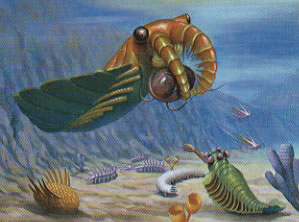 <Plate-1> Anomalocaris:
<Plate-1> Anomalocaris:
- Anomalocaris has captured a hapless trilobite, seized
in its anterior giant appendages which are maneuvering the prey
towards the armored mouth.
- On the sea-floor from left to center respectively are a solitary
specimen of Wiwaxia and three specimen
of Hallucigenia. Note in both animals
the defensive arrays of spines.
- Further to the right is the lobopodian Aysheaia with its anterior prongs around the mouth, as well as the primitive
arthropod Opabinia (five eyes) which is
a close relative of the largerAnomalocaris.
- Descending to the sea-floor are two individuals of the arthropod Marrella. Also visible in this scene
are sessil epifauna in the form of Dinomischus (yellow) and the sponge Vauxia (blue).
<図版1>アノマロカリス:
- アノマロカリスは不運な三葉虫をつかまえ、巨大な前足え頑丈な口へ餌として運ぼうとしている。
- 海底では左から中央へそれぞれ一匹のウィワクシアと3匹のハルキゲニアがいる。どちらの動物も防御としての針を持っている。
- さらに右側には口の周りに棘を持ったアユシェアイアがおり、また原始的な節足動物のオパビニア(5つ目)
がいる。これはより大きなアノマロカリスに近い種である。
- 海底の奥の方へ下ると、2匹のマレーラがいる。また定着性のディノミスクス(黄色)
やスポンジ状のボーキシア(青色) がいる。
>Top <Plate-2> Floaters:
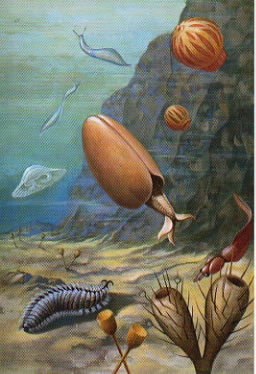
- The
emphasis in this picture is on the swimmers and floaters.
- In the foreground and ascending upwards is the arthropod Odaraia,
while higher in the water column are two individuals of the chordate Pikaia (left) and the ctenophore Ctenorhabdotus (right).
The gelatinous discoidal object on the left is Eldonia,
possibly a primitive echinoderm.
- On the opposite side is the enigmatic Nectocaris (reddish violet).
- Crawling across the sea-floor is a specimen of the polychaete
annelid Canadia (blue), whilst the
attached forms include the sponge Pirania with its elongate spicules upon which are attached some symbiotic
brachiopods, and also example of Dinomischus.
<図版2> 浮遊動物:
- これは遊泳動物や浮遊動物を示す。
- 前方から上に向かって、節足動物のオダライアと、その上方に2匹の脊索動物のピカイア(左側)
と2匹の有櫛(ゆうしつ) 動物であるテノラブドトゥス(右側) がいる
- 左側のゼラチン状の盤状の動物はエルドニアであり、おそらく原始的な棘皮動物である。
- 反対側には謎めいたネクトカリス(赤紫) がいる。
- 海底を這っているのは多毛性の環形動物であるカナディア(青色) であり、一方手前には海綿状の長く伸びた針をもつピラニアがあり、そこには共生している腕足動物が付着している。またディノミスクス(黄色)
も見える。
>Top <Plate-3> Mud-dwellers:
- Both mud-dwellers (infauna), and mud-stickers (sessile epifauna)
are shown.
- The most abundant infauna was Ottoia (brown), here three individuals are visible: one on the floor of
the large excavation, another in the process of consuming hyoliths
(mid-right), whilst the third is emerging from its burrow and displaying
its spinose proboscis (lower right).
- Two other priapulids are visible in the excavation; the elongate,
more-or-less horizontal worm is Louisella,
occupying an elongate burrow with openings to the overlying sea
water at either end.
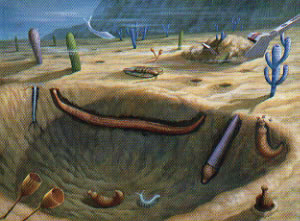 The animal inclined downwards, with its posterior end just emerging
from the sea-floor, is an example of Selkirkia.
It inhabited a parchment-like tube, and had a spiny proboscis that
was employed for burrowing.
The animal inclined downwards, with its posterior end just emerging
from the sea-floor, is an example of Selkirkia.
It inhabited a parchment-like tube, and had a spiny proboscis that
was employed for burrowing.- The other type of worm, visible in the excavation are two examples
of the polychaete annelid Burgessochaeta,
with one individual wriggling on the floor and the other in its
burrow with anterior tentacles extending sideways (far left).
- The sessile epifauna is represented by the enigmatic Dinomischus (lower left, like a orange daisy), the sponge Vauxia (blue), the cnidarian Mackenzia (green),
and the sponge Chancelloria (upper left,
purple).
- Also present is a trilobite (center) strolling across the sea-floor,
and swimming through the water a solitary Pikaia (a primitive chordate).
<図版3> 泥中生物:
- 泥中の棲む生物(インファウナ) と泥中にへばりつく生物(定着性エピファウナ) を示す。インファウナの代表的なのはオットイア(茶色)
で、ここでは3匹いる。1匹は掘削した穴の中で、もう1匹はヒオリス(軟体動物)を食べようとしている(中央右)、そしてもう1匹は棘のある吻を出している(右下)。
- 掘削穴にはもう2つの生物がいる。長くてほぼ水平の虫はルイセラであり、長い穴の中にいて両端は海水のすぐ下にいる。
- 斜め下に傾いて後部を海底にだしているのがセルカーキア(青紫色)である。それは羊皮のようなチューブに棲んでいて、穴を掘るために棘のある吻を持っている。
- 掘削した穴の中に見える水色の虫は、多毛の環形動物であるバージェソキータで、1匹は穴の底でもがいており、もう1匹は穴の中にいて後ろの触角を側面に延ばしている(左遠方)。
- 定着性の表存動物は不思議なディノミスクス(左下、橙色のヒナギクのような) 、海綿状のヴォーキシア(青白)
、刺胞(しほう) 動物のマッケンジア(緑色) 、海綿状のチャンセロリア(左上、紫色)
がいる。
- 中央には三葉虫が海底を這いずっており、水中を泳いでいるのは1匹のピカイア(原始的な脊索動物)
である。
>Top 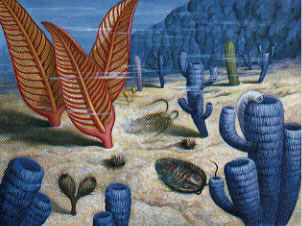 <Plate-4> Burgess Shale Community:
<Plate-4> Burgess Shale Community:
- This picture emphasized the epifaunal elements of the Burgess
Shale community. Attached to the sea-floor are various type of sponge
including the large Vauxia (blue), and Choia (center, resembling a pin-cushion).
- Further in the background are example of Dinomischus (yellow), Mackenzia (green), and Chancelloria (purple).
- The prominent group of three frond-like organisms on the mid-upper
left are example of the sea-pen Thaumaptilon.
- Moving across the sea-floor are also two trilobites.
- Trilobite:

A Middle Cambrian trilobite with a prominent bite mark on its right-hand
side, perhaps caused by an Anomalocaris attack. specimen
is about 4cm long. (Ohio State Univ.)
- Laterality:
Rather remarkably there is a marked preponderance of dextral
attacks. It suggests that either the attacker had a dextral
preference or there was a bias in the direction by which the
trilobite tried to escape.
 Pikaia: the earliest stages in the evolution of the phylum.
Pikaia: the earliest stages in the evolution of the phylum.
At the first sight the distance from Pikaia to a human
seems to be almost immeasurable. From an evolutionary viewpoint,
what matters is that our basic construction as chordates is clearly
visible in Pikaia. Many of the changes, notably the closure
of the gill slits and the development of the four limbs from preexisting
fins, are a direct consequence of the invasion of land in Devonian.
But the possession of the stiffening notochord and muscular myotomes
is a necessary first step.
- The brain of Pikaia was very small, but its basic
structure would have been similar to that of a primitive fish.
We can recognize that in its brain there were the first dim
stirrings of neural activity that half a billion years later
would emerge as fully fledged consciousness.
<図版4> バージェス頁岩コミュニティ:
- この図はバージェス頁岩のコミュニティにおける表在動物である。海底に付着しているのはスポンジ状のヴォーキシア(青色)
、チョイア(中央の針刺し状)、ずっと奥の方にはディノミスクス(黄色)
、マッケンジア(緑色)およびチャンセロリア(紫色)がある。
- 中央左側に目立つのは3つの葉状の生物で腔腸動物のタウマプティロン(茶色)である。
- 海底を動き回っているのは2匹の三葉虫である。
- <左図>三葉虫:
中期カンブリア紀の三葉虫で、右側におそらくアノマノカリスの攻撃を受けたであろう噛まれた跡が生々しく残っている。
- 三葉虫の噛み傷は右側の方が多い。攻撃した敵が右側を好んだのか、または三葉虫が逃げようとしたときの方向が右にかたよっていたのかどちらか。
- <左図>ピカイア:
脊索動物門の初期形態
一見するとピカイアと人類との距離は果てしなく遠い。しかし進化の観点からは、脊索動物としての我々人類の構造がピカイアにはっきりと現れている。多くの変化、特に鰓亀裂がふさがり、ヒレから四肢が発達したことなどは、デボン紀に動物が陸上に進出した結果生じた変化である。しかし堅い脊索と筋節を持つことがまず第一段階として必要である。
- ピカイアの脳は非常に小さいが、その基本構造は原始的な魚と似ている。その脳は神経活動のほのかな兆候があり、5億年後には立派に発達した意識として登場するのである。
>Top 5.
The search for new Burgess Shales:
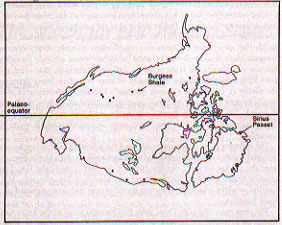
The ancient continent of Laurentia.
Each dot represents a fauna of Burgess Shale type, with the Burgess
Shale itself and Silius Passet specifically identified. Note that
the position of the paleo-equator and the broadly concentric distribution
of these faunas round the craton. The outline of Laurentia is
based on modern geography. All other Burgess Shale-type faunas
are marine, and so the coastline lay inward of these sites.
- The first trip to Sirius Passet in 1989:
Paleontologies are fortunate among scientists to travel to remote
areas. There is no doubt that the chief delight of the subject is
to explore the novelty of vanished worlds. But in addition to see
wilderness and experience a remoteness that, however intangible,
transports one far beyond the humdrum affairs of ordinary life.
The high Arctic is a strange paradox of expected harshness and unexpected
fertility. In the evanescent summer, flowers dot the landscape.
Bright purple and yellow stonecaps are complemented by Arctic buttercups
and poppies.
- The sun may be low in the sky, but it seems to bleach the
landscape. Here it looks like a remote and distant star. It
is an alien world, and one gets a glimpse of what might be the
fate of a planet circling a cooling sun, where life lingers
on the edge of a frozen world, before slipping to annihilation
and extinction as the star turns to embers.
- Chéngjiāng:
There is one locality that certainly rivals the Burgess Shale and
Sirius Passet assemblage. This is the famous Chengjiang fauna, about
50km south-east of Kumming, Yunan province, China.
- How is it that the faunas of Chengjiang and Burgess Shale
are relatively similar despite their separation from each other
in time, by 15 Ma, and space of a major ocean of many thousands
of km wide?
- Very early in the Cambrian period the predecessors of these
faunas flourished in shallow water, where food supplies were
most abundant. As the Cambrian progressed, however, levels of
competition continued to rise, so that the less successful species
were displaced into deeper water where competition was less
ferocious. Such displacement opened the possibility of migration
across the ocean floor to other areas.
- The rate of evolutionary change may be slower in deeper-water
environments. This might explain some of the similarities between
the Chengjiang and Burgess Shale faunas, despite the fact that
the latter is considerably younger.
5. 新たなバージェス頁岩の探査:
- <左図>古代大陸ローレンシア。
各点はバージェス頁岩タイプの動物群で、バージェス頁岩と シリウス・パセットの位置は個別に示してある。原始赤道の位置と、この地域の周りのこれらの動物群が大きな童心絵状に分布していることに注目。ローレンシア大陸の境界は現代の地理による。すべてのバージェス頁岩は海成で、その海岸線はそれらの場所から内部にあった。
- シリウス・パセットへの初旅行(1989):
古生物学者は遠方に旅することができるので科学者の中でも恵まれている。失われた世界の珍しい生物を探査するという古生物のテーマも楽しみである。それは単に未開の自然を見るだけでなく、平凡な日常生活を超えて夢中になることができる。北極は予想通りの荒々しさと予期せぬ豊饒さとが同居している。つかの間の夏には、花があたりに点在している。明るい紫と黄色の岩の頂は北極のキンポウゲとケシに引き立っている。
- 太陽は空に低くかかっているが、周辺の景色は白く色あせて見える。ここはどこか遠くの星のようである。別世界なのだ。そして冷えていく太陽を巡る惑星の運命がどのようになるのかをほんの少し垣間見るかのようである。そこでは凍った世界の片隅で生物が細々と生きており、やがては星が燃えさしとなるにつれて絶滅してしまう。
- 澄江(チェンジャン):chéngjiāng
パージェス頁岩やシリコン・パセットの群集に匹敵する場所がある。中国・雲南省、昆明の南東50kmにあるチェンジャン動物群である。ここは下部カンブリア系であって、しかもローレンス大陸からおそらく数千km離れた別の大陸に堆積したにもかかわず大量の節足動物が産出している。
- カンブリア紀の初期の頃、これら動物群の祖先は浅い海で繁栄していた。浅い海では食物が最も豊富だった。しかしカンブリア紀が進むにつれて生存競争が激しくなり、落ちこぼれた種はより競争の少ない深い海に移動していった。このような移動が大洋底を挟んでの種の移動の可能性を広げた。
- 進化の速度は、深い海の中の環境の方が遅いであろう。このことでバージェス頁岩動物群の方が年代が若いにもかかわらず、バージェスとチェンジャンとの類似性が説明できよう。
>Top 6. The significance
of the Burgess Shale:
- "Wonderful Life" by S.J. Gould:
He proposed that the sheer range of animal types (this range of
anatomy and morphology is referred to as disparity) was at its maximum
during the Cambrian. The disparity thereafter declined towards the
present day. Paradoxically, what appears to us today to be an amazing
variety of animals is an impoverished remnant of the former glories
of the past.
- It is always fun to imagine the 'What if?' of history.
- In Wonderful life S. Gould asked to imagine what
might be the outcome of rerunning the Cambrian explosion. Would
the world today look much the same? Would there be the same
end products? You and me, mice and horses, whales and eagles?
- Faunas of Ediacaran and Cambrian:
The roots of the Cambrian 'explosion' can almost certainly be traced
back to the Ediacaran assemblages. The overall differences between
the faunas of Ediacaran and Cambrian age are much more striking
than any similarities. Rather, the change that occurred between
the two faunas looks much more like a case of replacement.
- Did the Ediacaran faunas plunge into extinction, for whatever
reason, so that the Cambrian faunas took the opportunity to
occupy a world stripped of its former masters? Alternatively,
did the replacement of the Ediacaran faunas take place as a
result of the rise of Cambrian animals, the Ediacaran species
being extirpated because of bitter competition with the newly
evolving animals?
- When it comes to understanding the Cambrian explosion, it still
seems to be desirable to talk about a fundamental trigger that
may have initiated the entire process. This is because when animals appeared the world changed for ever. (The same may, incidentally,
also be true for the appearance of humans.)
- In part it almost certainly would have involved further genetic
reorganization. Of particular importance is the process known
as gene duplication. As the name suggest, an existing
gene is doubled up. The old gen continues to act in the usual
way, but the new one is potentially free to be employed for new
and perhaps unexpected functions.
6. バージェス頁岩の重要性:
- S.J.グールド著"Wonderful Life":
彼は動物のタイプの幅 (この解剖学的・形態学的な幅を異質性という) はカンブリア紀に極大化した。その後、異質性は現在に向かって減少してきている。逆説的だが今日我々にとって非常に多様にみえる動物群はかつての輝ける過去のやせ細った残滓なのである。
- 歴史上の「もしこうだったら?」を想像することは楽しい。
- Wonderful Lifeの中でS.グールドはこう問いかけている。「もし 歴史をもう一度カンブリア紀に戻したとしたら、結果はどうなっていただろうか。世界は今と同じになったであろうか。同じ最終結果を得ただろうか。あなたも私も、ネズミも馬も、鯨も鷲も今と同じだろうか。
- エディアカラとカンブリアの動物群:
カンブリア紀の「爆発」のルーツはほとんど確実にエディアカラ群集に遡ることができる。エディアカラの時代とカンブリア紀の動物群では、類似性より相違性の方がずっと目立っている。2つの動物群の間の変化は、何らかの交代劇が起こったように見える。
- エディアカラの動物群は何らかの理由で滅亡の方向についており、その結果カンブリア紀の動物群が以前の主たちのいない世界を占拠する機械を得たのか。それとも、エディアカラの動物群の交代はカンブリア紀の動物の興隆の結果、エディアカラの種は新たに興隆してきた動物との厳しい競争に敗れて姿を消したのか
- カンブリア紀の爆発を理解使用とするなら、プロセス全体を開始した根元的なトリガーについて話した方が望ましい。それは動物が出現したことによってそれ以降世界が全く変わってしまったことである。(人間の出現についても同じことが言える)
- 一部にはさらなる遺伝子の再編成があったと言える。特に重要なのは、遺伝子重複と呼ばれるプロセスである。これは既存の遺伝子が2倍に増えることをいう。古い遺伝子はそのまま同じ働きをするが、新しい遺伝子は新たな全く予期せぬ機能のために使うことができる。
>Top Animal architecture:
- Animals display an exuberance of design, but appear to have fundamental
similarity at a deeper genetic level. When one is trying to define
something, it may help to say what that thing is not, at least to
heighten the contrast.
- What then might define an animal? There must be one unique feature
in the genomic architecture.
- Body orientation, notably in the specification of the anterior-posterior
axis.
- Neural tissue and the conduction of nervous impulses
- Brains and intelligence, then consciousness
- sponges:
The first important step might have been a type of adhesion
of cell not only to stick together, but also to form an organized
body. (cell adhesion)
- cnidarian:
The most notable steps would have been the formation of tissues
that included a primitive nervous systems and the clear definition
of body axes.
- flatworm:
The body organization is now structured around a basic bilateral
symmetry. The tissues become increasingly complex and include
a well-defined nervous system with aggregations of neurons that
provide both nerve cords and a brain of sorts.
- A dangerous world:
Paramount was the onset and subsequent diversification of those
animals that hunt and consume other animals. These are predators.
- In contrast to Cambrian communities those of the Ediacaran
were largely free of predators.
- The main functions of external skeletons in the many animals
that possess them is to provide protection from attack.
- The most notable examples are from the cataphract covering animals.
動物の構造:
- 動物たちは豊富なデザインを楽しませてくれるが、遺伝学上では基本的に類似しているように見える。あるものを定義するには、少なくとも違いを際だたせるために、それが何でないかを考えてみるといいかも知れない。
- 何が動物を動物たらしめているのか。
- 体の方向性、特に体の前後軸
- 神経組織と神経伝達
- 脳と知性、そして意識
- 海綿(海綿動物門) :
最初の重要なステップは細胞を一緒にくっつけただけでなく、一つの組織化した体を形成したことである。(細胞接着)
- クラゲ(刺胞動物門) :
顕著な進歩は、原始的な神経組織をもつ組織、はっきりした体軸を形成したことである。
- ヒラムシ(扁形動物門) :
この体の組織はこの段階では左右対称で組織は複雑化している。また、ニューロンの集合体からなるはっきりした神経組織も含まれ、神経束と一種の脳も形成された。
- 危険な世界:
もっとも重要なのは、他の動物を捕獲したり食べてしまう動物が出現したことである。これらは肉食動物である。
- カンブリア紀の世界と対照的に、エディアカラの世界には肉食動物はほとんどいなかった。
- 多くの動物の外骨格の主な機能は攻撃からの保身である。
- 顕著な例としては、動物の甲鱗である。
>Top The unfolding ecological theater:
- Predators:
The presence of predators is a vital component in the maintenance
of ecological richness and biological diversity. This observation
appears to be paradoxical, but simple experiments in the natural
environment suggest otherwise.
- If the dominant predator is removed, not surprisingly
there is a population explosion among the various prey animals
as the ecological pressure is released. In many circumstances,
however, one species quickly rises to dominance, overwhelming
and smothering the others. The net result is a crash in
diversity, leaving a depauperate and dull community. If
the predator is then reintroduced, then its apparently disruptive
action will allow diversity to climb back towards its original
levels. The rise of Cambrian predators may have helped to
drive forward the 'explosion' in diversity.
- Grazing:
Of particular importance is the style of feeding known as grazing.
It is often exemplified by animals such as slugs and snails.
Their feeding apparatus consists of a specialized rasping structure
(radula). This is protruded through the mouth to scratch away
thin films composed of algae and bacteria. In marine environments,
however, grazing encompasses a number of other groups, notably
the sea urchins (echinoids) and various molluscs, notably some
snails and the less well-known chitons.
- The influence of grazing on the Cambrian ecologies may
well have been analogous to that of predation. Just as the
primary role of animal skeletons was to provide a protective
shield, the extensive development of calcareous deposits
in different sorts of algae was an attempt to cushion the
effects of grazing.
- Phosphate:
The world's most important mines that extract this phosphate, largely
to provide agricultural fertilizer, are situated in rocks of Cambrian
age. Some geologist believe that there could be a direct correlation
between the Cambrian explosion and this episode of phosphogenesis.
生態系劇場:
- 肉食動物:
補色は生態系の豊富さや生物の多様性を維持する上で非常に重要な要素である。これは矛盾に見えるかも知れないが、自然観光で行われた簡単な実験はそうでないことを示している。
- もし支配的な肉食動物が除かれたら、当然ながら生態的な圧力が弱まり、餌食となるはずの動物群が激増してしまう。しかし多くの場合、一つの種類が数の上で他の動物を圧倒して急に勢力を増す。結果として多様性は崩され、貧弱で不活発な生物社会となる。もし肉食動物をそこに戻してやると、その外見上破壊的な行為によって、多様性は元のレベルに戻るだろう。このことからカンブリア紀の肉食動物の出現が多様性への爆発の動きを促進したと思われる。
- グレージング:
特に重要な摂食様式はグレージングと呼ばれるものである。それはナメクジやカタツムリのよな動物の例に見られる。これらの動物の摂食器官は特別なやすりのような構造になっており(歯舌)、この歯舌は口から突き出て藻やバクテリアの薄膜を引っ掻き取る。海中では他にウニや様々な軟体動物、特に巻貝やあまり有名でないヒザラ貝などがこのグレージングによって摂食する。
- このグレージングによるカンブリア紀の生態系への影響は、補食による影響と似たようなものだった。動物の骨格の第一の役割が敵から身を守るものだったと同じように、様々な藻類において石灰質の沈着が広く見られるようになったのは、グレーザーに襲われにくくする防御であったと考えられる
- リン酸塩:
リン酸塩鉱床のうち、世界最大規模の鉱床はカンブリア紀のものである。リンは生命にとって重要な栄養素なので、カンブリア紀の爆発とリンが増えたこととの関係を指摘する地質学者もいる。
>Top 7. Other worlds:
- Could we say that the emergence of modern humans was inevitable?
Probably not as recently as 4 million years ago, when our australopithecine
ancestors could be regarded as just another type of ape. Rather
surprisingly, perhaps not even a mere 150,000 years ago, when anatomically
modern Homo sapiens evolved. This is because in the first half of
our history the behavior of our species seems to be strangely conservative
and unimaginative. The real breakthrough in terms of Paleolithic
art and haunting technology occurred only about 50,000 years ago.
- "After Man" by Dougal Dixon (1981):
A zoology of the future. He asks the reader to envisage a world
that is emerging from an earlier ecological catastrophe. In this
book he supposes that of all the mammals only a handful or types,
mostly rats and rabbits, survived to repopulate the globe.
- Convergence:
Although there may be a billion potential pathways for evolution
to follow from the Cambrian explosion, in fact the real range of
possibilities and hence the expected end results appear to be much
more restricted. The outcome of evolutionary processes might be
rather predictable.
- This is the phenomenon that animals (as well as plants and
other organisms) often come to resemble each other despite having
evolved from very different ancestors.
- For much of the Tertiary (began about 65 Ma), South America
was isolated surrounded by oceans, a sort of super-island. Once
isolated, South America turned into a sort of natural laboratory
as the mammals underwent a rapid evolutionary radiation. An enormous
variety of forms appeared at one time or another such as giant
sloths (weighing 4 tons), and armadillos as big as a military
tank. The most famous example is a sabre-tooth marsupial 'cat',
very similar to the sabre-tooth tigers of the Northern Hemisphere.
- Another super-island, Australia, the indigenous mammal fauna
still flourishes. Here, too, there are some striking instances
of evolutionary convergence. In the Northern Hemisphere a common
mammal is the mole. In Australia there is a marsupial equivalent.
Marsupials and placentals are both mammals and so share a common
ancestor, lived about 100 Ma ago.
7. 別の世界:
- 現代の人間の出現は必然的だったのだろうか。我々の祖先であるアウストラロピテクスが現れた4百万年より前でも必然とは言えなかった。驚くべきことに現代人と解剖的には同じ体をしたホモサピエンスが現れた15万年前でもまだそうとは言えないだろう。なぜなら人類はその歴史の前半においては、奇妙なほど保守的で想像力に欠けていたように見えるからである。旧石器時代の美術や狩猟技術などの真の飛躍はほんの約5万年前に起こったのだ。
- 「人類の後に」D.ディクソン、1981年著未来の動物学。彼は以前に起こった生態系の破滅の後の世界はどうなるのかを読者に想像するように問いかけている。この本の中では、哺乳類の内ネズミやウサギなどわずかな種類だけが生き残って、地球上にもう一度広がっていくというものである。
- 収斂:
カンブリア紀の爆発以降の進化の可能性の道筋は何十億通りもあったかも知れないが、実際の可能性の幅、すなわち起こった結果はかなり限定されているように見える。進化のプロセスの結果はむしろ予測可能とも言える。
- 祖先が全く違うにもかかわらず、動物(植物その他の生物も)互いに似てくるという現象である。
- 第三紀(6500万年前)の間、南米は海に囲まれて孤立しており、巨大な島のようであった。一旦孤立すると南米は実験室のようになり哺乳類が急速に進化し放散していった。こうして4トンもの巨大なナマケモノとか、戦車のように大きなアルマジロ
などの動物が現れた。最も有名なのは有袋類の剣歯ネコであり、これは北半球で見られた剣歯トラとよく似ている。
- もう一つの巨大な島、豪州では固有の動物相はまだまだ豊富である。ここでも収斂進化の例が見られる。北半球のありふれた哺乳類にモグラがいる。豪州にもそれに対応する有袋類の動物がいる。有袋類と有胎盤類はいずれも哺乳類であり、約1億年前の共通の祖先をもつ。
>Top 8. The last
word:
- If indeed we are alone and unique, then we have special responsibilities.
First as alluded to above, our present behavior is little short
of reckless. Second, it follows that we have special duties to our
descendants, as least to leave the world a little better than we
found it.
- But there is also a unique privilege. That is to understand a
little or our history. For some it will be the investigation of
the past few centuries; for others the search for the origin of
mankind. Yet others will wish to reach further back in geological
time to discover in the Cambrian period the seeds of our own destiny.
8. おわりに:
- もし我々人類が本当に唯一無二の存在であるとすれば、我々には特別の責任がある。まずは、現在の我々の行動はほとんど無謀に近い。次には、少なくとも現在よりましな世界を次世代に残さなければならないという責任である。
- そのためには特別のやり方がある。それは我々の歴史を少しは理解することである。ある人たちにとっては、過去数世紀を調査することであろうし、他の人たちにとっては人類の起源を調べることになろう。また別の人たちにとっては、もっと地質時代の昔に遡ってカンブリア紀を探査したいと思うだろう。
Comment
- There are
several epoch making events in the Earth history. The extinction of
dinosaurs was one of them.
- The explosive evolution of living creatures happened in the Cambrian
period was also surely another epoch making event, where there were
many dramatic scenes occurred, having effected the present nature, including
us.
- 地球の歴史にはいくつかの画期的な出来事がある。恐竜の絶滅はその一つであった。
- カンブリア紀に起こった生物の爆発的な進化もまた確かにもう一つの画期的な出来事だった。そこでは多くの劇的な場面が起こり、それはまた我々を含む現在の自然に影響を与えている。
 |
The Crucible of Creation- The Burgess Shale and the Rise of Animals -
|
Cat: SCIPub: 1998#: 0218b |
Simon Conway Morris |
02531u/18216r |
Title |
The Crucible of CreSummaryation |
生命創造のるつぼ: |
|---|---|---|
Author |
Simon Conway Morris | サイモン・C・モリス |
Index |
||
Why? |
|
|
Summary |
要約 |
>Top 1. The imprint of evolution:
|
1. 進化の刻印:
|
>Top Organic diversity:
|
種の分化:
|
>Top 2. Setting the scene:
|
2. 生命の舞台:
|
>Top The structure of life:
|
生命の構造:
|
>Top Eukaryotes;
|
真核細胞:
|
>Top Prokayote
|
原核細胞:
|
>Top Ediacaran:
|
エディアカラ動物群:
|
>Top Cambrian period (550-485 Ma):
|
カンブリア紀: (550 - 485 Ma)
|
>Top 3. The discovery of the Burgess Shale:
|
3. バージェス頁岩の発見:
|
>Top Nomenclature:
|
命名法:
|
>Top 4. Journey to the Burgess Shale:
|
4. バージェス頁岩への旅:
|
|
<図版1>アノマロカリス:
|
>Top <Plate-2> Floaters:
|
<図版2> 浮遊動物:
|
>Top <Plate-3> Mud-dwellers:
|
<図版3> 泥中生物:
|
>Top
|
<図版4> バージェス頁岩コミュニティ:
|
>Top 5. The search for new Burgess Shales:
|
5. 新たなバージェス頁岩の探査:
|
>Top 6. The significance of the Burgess Shale:
|
6. バージェス頁岩の重要性:
|
>Top Animal architecture:
|
動物の構造:
|
>Top The unfolding ecological theater:
|
生態系劇場:
|
>Top 7. Other worlds:
|
7. 別の世界:
|
>Top 8. The last word:
|
8. おわりに:
|
Comment |
|
|